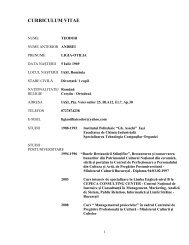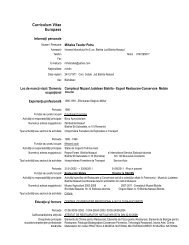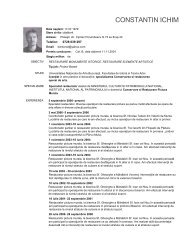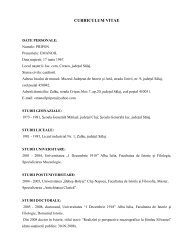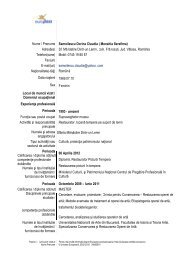e-conservation the online Magazine 16, oct 2010.pdf
e-conservation the online Magazine 16, oct 2010.pdf
e-conservation the online Magazine 16, oct 2010.pdf
Create successful ePaper yourself
Turn your PDF publications into a flip-book with our unique Google optimized e-Paper software.
IDENTIFICATION OF IVORY BOOK COVERS<br />
and texts. The Carolingian period marked a revival<br />
of ivory carving [10], particularly in ecclesiastical<br />
furniture, reliquaries, and book covers [1]. Charlemagne<br />
sought to recreate <strong>the</strong> glory and culture of<br />
ancient civilizations by having scribes and artists<br />
copy classical texts and illustrations, including<br />
many books of lavish miniatures and gold and/or<br />
ivory covers [10]. After <strong>the</strong> Carolingian revival,<br />
ivory continued to be used for making fine book<br />
covers for treatises of special merit or religious<br />
manuscripts [1].<br />
A less figurative and more decorative design became<br />
more common in <strong>the</strong> later years. This is more<br />
representative of <strong>the</strong> simple, elegant designs of<br />
<strong>the</strong> three deaccessioned books, as <strong>the</strong>y are from<br />
<strong>the</strong> late 19 th century. Book 1 has four fleur-de-lis<br />
additions on <strong>the</strong> front and back, and an ink emblem<br />
on <strong>the</strong> center medallion. Book 2 has a simple<br />
yet beautiful oval medallion and surrounding engraving,<br />
while Book 3 includes an asymmetrical<br />
center addition.<br />
Ivory Use in Portrait Miniatures<br />
books, so miniaturists continued to illustrate books<br />
but also offered patrons independent miniatures<br />
[11]. In <strong>the</strong> 1520s, individual portraits in miniature<br />
size were first produced at French and English<br />
courts on a portable piece of parchment or<br />
vellum [11]. This transfer of art technique relied<br />
on an understanding of <strong>the</strong> close association between<br />
<strong>the</strong> materials and techniques of <strong>the</strong> illuminated<br />
book and <strong>the</strong> early miniature on parchment<br />
[12]. It is interesting to consider <strong>the</strong> implication<br />
on portrait miniatures had an early ivory book been<br />
present and considered for <strong>the</strong> same transfer of<br />
application.<br />
Instead, small scale portrait images were painted<br />
in a range of materials, styles, and techniques,<br />
from water-based paints on paper or card supports,<br />
to fired enamels on gold or copper supports, and<br />
oil paints on metal, stone, glass and tortoiseshell<br />
[12]. However, <strong>the</strong> most significant early methods<br />
of painting portraits were on parchment or vellum,<br />
called limnings, becoming known as portrait miniatures<br />
in <strong>the</strong> 18 th century when <strong>the</strong>y began to be<br />
painted on ivory [12].<br />
The use of ivory in books seems to have not experienced<br />
a specific period of use, but ra<strong>the</strong>r was in<br />
use periodically throughout history. In contrast,<br />
portrait miniatures were very popular during a<br />
400 year time period. Both ivory objects are intended<br />
to show a kind of devotion; <strong>the</strong>se particular<br />
books to display religious beliefs, and <strong>the</strong> portrait<br />
miniatures to commemorate a loved one or<br />
important figure. The books were likely on display<br />
in a home when <strong>the</strong>y were not in use as a Catholic<br />
missal to celebrate Mass throughout <strong>the</strong> year, however,<br />
<strong>the</strong> miniatures were often more personal than<br />
for display.<br />
Notably, early portrait miniatures were derived<br />
from illuminated manuscripts. From <strong>the</strong> 1460s,<br />
handwritten books had to compete with printed<br />
The first watercolour portraits on ivory tablets<br />
were attributed to <strong>the</strong> Venetian artist Rosalba<br />
Carriera [13]. These were initially used as bases<br />
or lids for boxes [13], much like <strong>the</strong> repurposing<br />
of diptychs and plaques for early ivory books.<br />
Carriera ga<strong>the</strong>red fame throughout Europe for<br />
<strong>the</strong> beauty of <strong>the</strong> ivory visible through <strong>the</strong> transparent<br />
paint in flesh coloured areas [13]. By 1710,<br />
artists internationally faced pressure to conform<br />
to this new fashion despite <strong>the</strong> difficulty of painting<br />
watercolour on <strong>the</strong> unabsorbent ivory [13].<br />
After <strong>the</strong> introduction of ivory as a support for portrait<br />
miniatures, parchment use began to decline<br />
until it stopped entirely [12]. The popularity of <strong>the</strong><br />
portrait miniature was decreasing by 1839 with <strong>the</strong><br />
introduction of <strong>the</strong> daguerreotype, a few decades<br />
e-<strong>conservation</strong><br />
29



